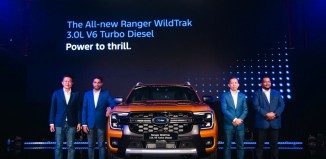Super SUV from Porsche
Throughout the 1990s, while most segments of the auto market went up and down, demand for sport-utility vehicle (SUVs) – Malaysians usually call them ‘4x4s’ or ‘4WDs’ – kept rising, especially in the US market. While the introduction of smaller models like the Toyota RAV4 and Honda CR-V converted many sedan owners, there was still a noticeable preference for larger SUVs which were once considered too spartan and uncomfortable for daily use.
The significance of this segment and growing demand was not missed by the automakers, even those in the luxury segment. For a long time, the ‘luxury SUV’ was the Range Rover and it had no peers; in 1989, the same company brought out the Discovery and it too had few rivals – for a while.
Then all of a sudden, it seemed like every manufacturer was adding a SUV to its line-up. In the mid-1990s, the most significant introduction was the M-Class by Mercedes-Benz which had been primarily intended for the US market, and the German automaker even built a factory there for the purpose. The other German luxury automakers quickly announced their own offerings – BMW with the X5 and Audi with the AllRoad – while Toyota’s brand, Lexus, also had a SUV in the form of the RX300 (Toyota Harrier). And as you will have read, Volvo also has some new SUVs coming later this year.
Porsche, better known for its legendary sportscars, has now joined the SUV crowd with the Cayenne (the name means ‘spice’ in certain languages), a model which it says will ‘set standards in the SUV segment’. It is a totally new design incorporating many impressive, pioneering technologies and is not based on any previous model. The same platform will also be the basis for VW’s Colorado SUV, to be announced later.
Like the BMW X5 which has impressive capabilities on highways and yet can perform well in off-road conditions, the Cayenne is claimed to be an extremely sporty vehicle capable of being driven off-road when necessary. Incidentally, Porsche is not totally a stranger to off-roading – you may remember that the company entered some specially-modified cars in the Paris-Dakar Rallies during the 1980s.
Among the many technical highlights are totally new 4.5-litre, V8 engines. The Cayenne S will have an engine rated at 250 kW/340 bhp with maximum torque of 420 Nm, while the Cayenne Turbo’s engine will develop 331 kW/450 bhp with 620 Nm of torque available.
Porsche says these figures guarantee exceptional performance: for the 0 to 100 km/h sprint, the non-turbo Cayenne S will need 7.2 seconds and go on to a top speed of 242 km/h, while the Turbo version will rocket to 100 km/h in just 5.6 seconds and stop the speedometer needle at 266 km/h. Incredible performance for a SUV but unless you are James Bond fleeing from the bad guys in Afghanistan, such performance would hardly be needed off-road…
A 6-speed Tiptronic S transmission is standard equipment on the Cayenne Turbo. Both Cayenne versions have all-wheel drive and the Porsche Stability Management system (a very sophisticated form of traction control), further developed to suit the specific needs of this type of vehicle. An inter-axle differential lock and additional low-range gears will be incorporated for difficult off-road conditions.
As well as offering sportscar standards of performance, agility, handling and braking, the Cayenne features the latest chassis and suspension design developments that claim to yield standards of ride quality and refinement never before available in this category.
The Cayenne’s low bonnet and strikingly-styled headlamps will immediately link it to the Porsche family. The range-topping Cayenne Turbo has certain visual features that distinguish it from the non-turbo version: additional air inlets at the front, power domes on the bonnet and four exhaust tailpipes. The latter have a slight effect on the overall length: the Cayenne S is 4782 mm long; its more powerful turbocharged counterpart 4786 mm. It’s therefore hardly a compact vehicle (a Land Rover Discovery is 4705 mm) with a width of 1928 mm and a wheelbase of 2855 mm. With the necessary ground clearance, it stands very much higher than its coupe brothers at 1699 mm.
Malaysian distributor Auto Eurokars has not announced possible pricing for the Cayenne (imported by Jaseri Automotive Group, the official Porsche importers) nor when units will be available but it is likely to be a while since Porsche will usually make the lefthand drive versions first.

























